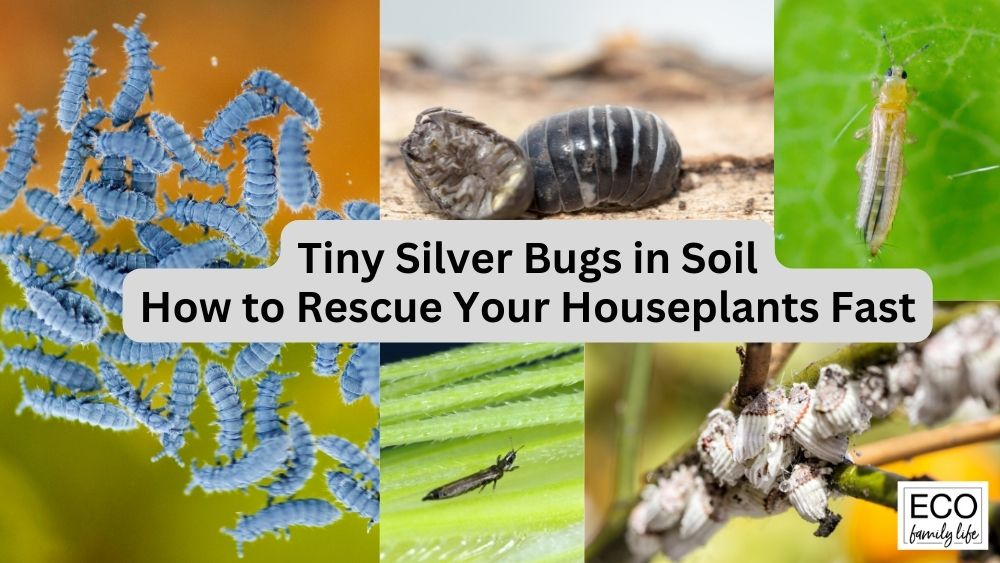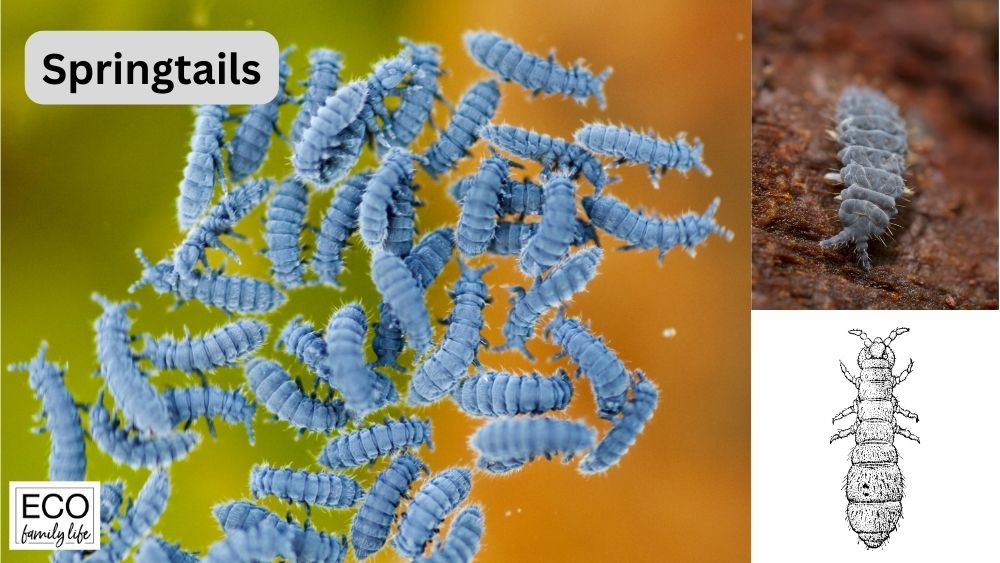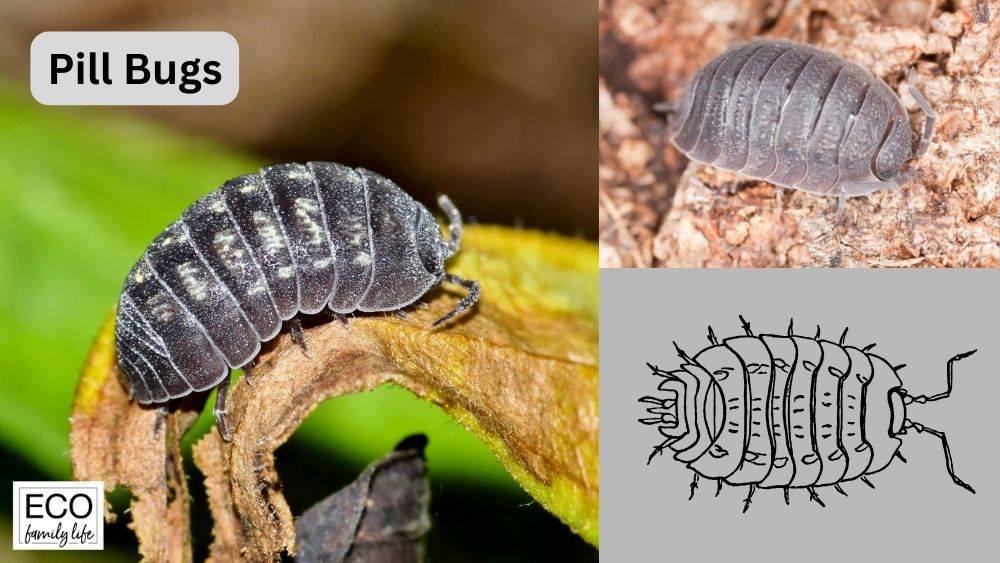Tiny silver bugs crawling around in your houseplant soil are usually springtails. There are other common tiny silver bugs including Thrips, Pill Bugs, Springtails and Mealybugs. If left unchecked they can damage your house plants, they are also unsightly and annoying. To get rid of these tiny silver bugs you can reach for natural remedies like diatomaceous earth and Neem oil or chemical insecticides.
This article will also cover ways to stop silver bugs from damaging your houseplants.

4 Tiny Silver Bugs and How to Control Them
Here are 4 common tiny silver bugs that can infect your houseplants. Find out how to identify them and control them before they damage your plants.
1. Springtails

Silver bugs or springtails are usually silver or gray but can also look like tiny white bugs. They are challenging to see with the naked eye due to their tiny size and quick movements. However, under certain conditions and with good lighting, it is possible to spot them, especially when they jump. They thrive in moist soil conditions and are harmless to humans and pets but can cause damage to your plants if not controlled.
They are typically less than 1/16 inch in length and have a distinctive tail-like appendage that helps them jump which you cans see with a magnifying glass. You may also notice them in large numbers on the surface of the soil or crawling around the plant roots. To determine if you have springtails, you can try tapping the soil surface with a piece of white paper. If the bugs jump onto the paper, they are likely springtails.
They thrive in moist soil conditions and can multiply quickly if left unchecked. Other bugs that may be mistaken for springtails include fungus gnats and spider mites. Understanding the differences between these pests can help you choose the best method for eliminating them from your plants.
How to Control Springtails
Check out the following methods to control springtails on your houseplants.
Diatomaceous Earth
Diatomaceous earth is a natural substance that is made from the fossilized remains of diatoms, which are tiny aquatic organisms. It is a fine powder that is safe for humans, but deadly for insects. When insects come into contact with diatomaceous earth, it dries out their exoskeletons, causing them to die.
To use diatomaceous earth to get rid of springtails sprinkle a thin layer on the surface of the soil. Use a small brush to gently work the powder into the top layer of soil and repeat this process every few days until the silver bugs are gone.
Neem Oil
Neem oil is a natural insecticide that comes from the seeds of the Neem tree. The good news is that it is safe for humans and pets, but deadly for insects. When insects come into contact with neem oil, it disrupts their hormonal balance, causing them to stop feeding, mating, and laying eggs.
To use Neem oil the first step is to dilute it with water in a spray bottle. Follow the instructions on the pack. Shake the bottle well to mix the solution then spray it on the surface of the soil and the leaves of the plant. Repeat this process again in a week until the silver bugs are gone.
Insecticidal Soaps
Insecticidal soaps are a safe and effective way to control silver bugs. They work by penetrating the insect’s outer shell, causing dehydration and ultimately death. Insecticidal soaps are made from natural ingredients and are safe for use on most houseplants. You can also use an organic detergent to make up your own soap spray. Add 1-2 drops of organic dish detergent to a spray bottle and coat the insects with the soapy water.
To use insecticidal soap, mix the recommended amount with water and spray directly onto the affected plants and soil. Be sure to follow the label instructions carefully, as overuse can damage plants.
Insecticides
Insecticides are another effective way to control silver bugs. These insecticides are absorbed by the plant and when the silver bugs feed on the plant, they ingest the insecticide and die.
Insecticides are available in both liquid and granular forms. To use, simply apply the recommended amount to the soil around the affected plants. Be sure to follow the label instructions carefully, as overuse can damage plants.
2. Thrips

Thrips are a common houseplant pest. They are tiny, slender insects that belong to the order Thysanoptera. They are typically less than 1/16 inch (1-2 mm) in length and have fringed wings. They have piercing-sucking mouthparts that they use to puncture plant cells and feed on the plant’s sap.
This can cause stippling or silvering of leaves and affect plant growth. Thrips can also transmit plant viruses. Thrips can enter homes through open windows, open doors, in leaf litter or mulch or on infested plants brought inside. These tiny insects they can easily spread from plant to plant.
How to Control Thrips in Houseplants:
Neem oil is a natural and organic insecticide that can effectively control thrips on houseplants. It works by disrupting thrips’ feeding and reproductive processes.
Simply mix neem oil with water following the instructions on the product label. Spray the solution evenly on the foliage and stems of your houseplants, ensuring good coverage.
Repeat the application every 7-10 days or as recommended on the label to target newly hatched thrips and break their life cycle before they cause serious damage.
Neem oil is available from good garden centers.
3. Pill Bugs

Pill Bugs, (also known as sowbugs or woodlice) are terrestrial crustaceans. They live in damp, decaying organic matter and are usually less than 1 inch (2.5 cm) in length. Pill bugs are mostly scavengers that feed on decomposing organic matter, such as dead leaves, mulch, and decaying wood. While they are not plant pests themselves, they may indirectly affect houseplants by eating the mulch or other materials in pots.
Pill bugs are attracted to moisture and can thrive in overly damp potting soil. If soil conditions are consistently too wet, they may gather in plant pots, potentially disrupting the root zone.
They seek shelter in dark, moist environments during the day and may hide under pots, in saucers, or among plant debris and are more active at night.
How to control pill bugs in houseplants
The best ways to control pill bugs in houseplants is to let the top soil of your houseplant dry out between watering, avoid overwatering and make sure your pots have adequate drainage.
You can also remove excess mulch from the top of the pot and remove the bugs at the same time. Simply take the affected plant outside and pour the mulch off the surface out into your compost heap. You can take the time to manually remove the bugs with a small spade or gloved hand.
Pill bugs are generally harmless to houseplants and play a role in decomposing organic matter, contributing to nutrient cycling in the soil. In most cases, they are not considered pests of indoor plants. However, if their population becomes excessively large it is best to remove them.
4. Mealybugs

Mealy bugs are small, soft-bodied insects that are common houseplant pests. They are typically found on the stems, leaves, and in the leaf axils of plants. They have oval-shaped bodies, are usually colored gray or white and can be covered in a white, waxy substance. This wax gives them a cottony or mealy appearance and serves as protection.
Mealybugs feed by piercing the plant tissue with their needle-like mouthparts and sucking out the plant’s sap. This feeding can weaken the plant, causing stunted growth, yellowing leaves, and leaf drop. In addition to the physical damage, mealybugs excrete a sticky, sugary substance called honeydew, which can attract ants and promote the growth of sooty mold on plant surfaces.
How to control mealybugs
As soon as you notice mealybugs on one of your houseplants, isolate the infested plant to prevent the spread of the pests. Use a soft brush or a cotton swab dipped in rubbing alcohol to gently remove the mealybugs from the affected areas. Focus on areas where the insects are concentrated, such as leaf axils and the undersides of leaves.
If the infestation is severe, prune off the heavily infested branches or stems and dispose of them in a sealed plastic bag. Apply insecticidal soap or Neem oil to the affected areas of the plant. They help control mealybugs by suffocating them or disrupting their outer waxy layer. Mealybugs are persistent pests, and you may need to repeat treatments every 7-10 days to target newly hatched mealybugs and any survivors.
Preventing Silver Bug Infestation in Houseplants
To prevent a range of tiny silver bugs including thrips, mealybugs or springtails from infesting your houseplants, check out these easy tips.
1. Proper Watering Techniques
One of the most important things you can do to prevent bug infestations is to water your houseplants properly. Overwatering can create the moist environment that many bugs thrive in. On the other hand, underwatering can cause stress to your plants, making them more susceptible to pests.
To water your plants properly, make sure to:
- Water your plants only when the top inch of soil is dry to the touch.
- Water your plants thoroughly, allowing excess water to drain away.
- Avoid leaving standing water in saucers or trays.
2. Choosing the Right Soil
Choosing the right soil for your houseplants can also help prevent silver bug infestations. Bugs thrive in moist soil, so it’s important to choose a well-draining soil mix that allows excess water to drain away.
When choosing soil for your houseplants, look for soil mixes that:
- Contain perlite or vermiculite to improve drainage.
- Are designed specifically for the type of plant you’re growing.
- Are free from pests and disease.
3. Regular Inspection of Houseplants
Regular inspection of your houseplants can help you catch silver bug infestations early, before they become a major problem. Inspect your plants regularly for signs of silver bugs, such as tiny silver or white bugs crawling on the soil surface or around the base of the plant.
To inspect your plants properly, make sure to:
- Check the soil surface and around the base of the plant for signs of silver bugs.
- Look for any other signs of pest infestation, such as webbing or discoloration.
- Remove any dead or damaged leaves or stems from the plant.
How to Keep Silver Bugs Out of Houseplants
Keeping your houseplants free of bugs is crucial for their health and longevity. Here are some tips on how to maintain bug-free houseplants.
1. Regular Cleaning
Cleaning your houseplants regularly is an essential step in preventing bug infestations. Dust and debris can accumulate on the leaves, creating a perfect breeding ground for pests. To clean your plants use a soft, damp cloth to wipe down the leaves. Avoid using harsh chemicals or soaps as they can damage the leaves.
Regular cleaning not only helps prevent bugs but also keeps your houseplants looking healthy and vibrant.
2. Pruning
Pruning your houseplants is an effective way to prevent bug infestations. Dead or damaged leaves can attract pests, so removing them promptly can help keep bugs at bay. Here are some tips on how to prune your houseplants:
- Use clean, sharp scissors or pruning shears to remove old leaves or branches.
- Cut at a 45-degree angle to promote new growth.
- Remove any dead or damaged leaves, stems, or flowers to reduce the pests food sources.
3. Good Lighting
Providing your houseplants with the best lighting conditions is essential to keep bugs away. Poor lighting conditions can weaken your plants, making them more susceptible to bug infestations. Here are some tips on how to provide optimal lighting conditions for your houseplants:
- Research the lighting requirements of your specific plant.
- Place your plant in a bright, sunny location if it requires direct sunlight.
- If your plant requires indirect sunlight, place it near a window with filtered light.
Frequently Asked Questions
How can I eliminate tiny silver bugs from my houseplant soil?
To eliminate tiny silver bugs from your houseplant soil, you can sprinkle diatomaceous earth on the soil surface. This substance is made from fossilized aquatic organisms and contains silica, which kills insects by drying them out. Another option is to use Neem oil, which works as a natural insecticide and repels silver bugs. You can also try using sticky traps, which capture the bugs and prevent them from multiplying.
How do I prevent silver bugs from infesting my houseplants?
To prevent silver bugs from infesting your houseplants, you should avoid overwatering your plants and make sure the soil is well-draining. Silver bugs thrive in moist soil conditions, so keeping the soil dry will discourage them from taking up residence. Additionally, you can use a soil mix that contains perlite or vermiculite, which improve drainage and prevent soil from becoming too compact.
What are some natural remedies for getting rid of silver bugs in houseplant soil?
Some natural remedies for getting rid of silver bugs in houseplant soil include using Neem oil, diatomaceous earth, or sticky traps. You can also try spraying the soil with a mixture of water and dish soap, which suffocates the bugs and prevents them from breathing. Additionally, you can add beneficial nematodes to the soil, which are microscopic worms that feed on silver bugs and other soil-dwelling pests.
Are there any chemical treatments for eliminating silver bugs from houseplant soil?
While there are chemical treatments available for eliminating silver bugs from houseplant soil, it is generally not recommended to use them. Chemical treatments can harm beneficial organisms in the soil and may be toxic to pets or children. It is best to use natural remedies or preventative measures to control silver bug populations.
I am an accredited practicing dietitian, experienced gardener and a dedicated cook. I love writing and sharing my experience so you can learn from my successes and mistakes.
